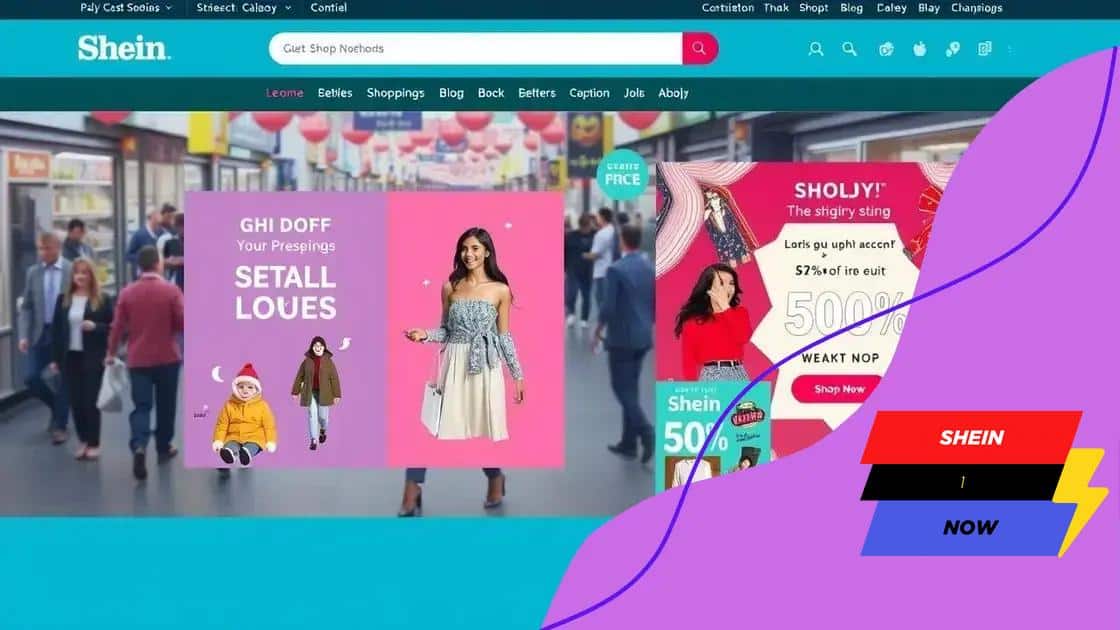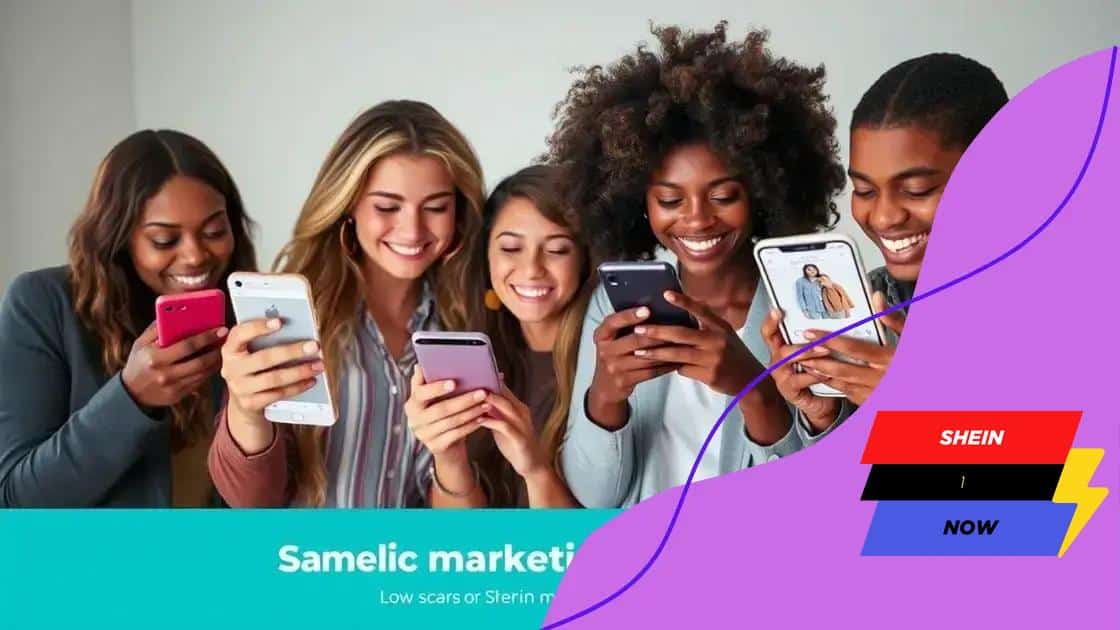Shein’s promotional campaigns and financial impact revealed

Shein’s promotional campaigns leverage social media, influencer partnerships, and data analytics to effectively engage consumers, driving significant sales and adapting to future trends in the fast-fashion industry.
Shein’s promotional campaigns and financial impact are reshaping the fashion retail scene. Ever wondered how a brand can thrive so rapidly? Join me as we delve into Shein’s marketing genius and its effects on consumer habits.
The evolution of Shein’s promotional strategies
The evolution of Shein’s promotional strategies has been remarkable and impactful. Over the years, Shein has adapted its marketing techniques to keep up with changing consumer behaviors and the dynamic online shopping landscape. This adaptability allows Shein to remain competitive as a leader in the fast-fashion industry.
Initially, Shein focused heavily on influencer marketing, partnering with social media stars to promote its products. This strategy effectively boosted brand visibility and attracted a younger audience. The brand’s unique approach to using micro-influencers helped it tap into niche markets, creating a strong community of loyal customers.
Shifts in Promotional Focus
As the brand grew, Shein adjusted its promotional focus. Here are some significant changes in its marketing tactics:
- Seasonal Sales: Annual promotions and seasonal discounts became a cornerstone of the marketing strategy.
- Engaging Content: The use of engaging and interactive content on social media platforms increased.
- Flash Sales: Limited-time offers created a sense of urgency, driving more sales.
- User-Generated Content: Shein encouraged customers to share their outfits and experiences, further enhancing community connections.
The emergence of data analytics has also played a crucial role in refining Shein’s marketing strategies. By leveraging consumer data, Shein can analyze trends and customer preferences, allowing for targeted promotions that resonate with buyers. This data-driven approach keeps Shein at the forefront of fashion trends while enhancing customer satisfaction.
Another key aspect is the collaboration with various brands and designers. By partnering with varying artists, Shein continually evolves its product offerings, appealing to diverse segments of the market. These partnerships help Shein reach new audiences and expand its influence beyond typical fast-fashion boundaries.
In conclusion, the evolution of Shein’s promotional strategies reflects the brand’s agility and keen understanding of market dynamics. Keeping pace with trends and consumer needs has allowed Shein to thrive in a competitive environment, maintaining its status as a leading online fashion retailer.
Analyzing the financial success of Shein
Analyzing the financial success of Shein reveals critical insights into how the brand has thrived in the competitive fashion industry. Over the years, Shein has seen remarkable revenue growth, which can be attributed to a combination of innovative strategies and market understanding.
One prominent factor is Shein’s efficient supply chain management. By utilizing advanced logistics and direct sourcing, Shein can quickly respond to market trends and reduce overhead costs. This efficiency allows them to offer trendy items at competitive prices, appealing to a broad customer base.
Revenue Growth Metrics
Shein’s financial success can also be measured through key metrics, such as:
- Annual Revenue: Reports indicate that Shein’s revenue has surged, with billions earned annually.
- Market Share: Shein has captured a significant segment of the online fast-fashion market.
- Customer Acquisition: The brand has successfully attracted millions of new customers each year.
- Return on Investment: Shein’s marketing efforts yield high returns through effective ad spend.
Another indicator of Shein’s success includes its ability to leverage data analytics. By analyzing consumer preferences and shopping behaviors, Shein creates tailored marketing campaigns that resonate with its audience. This targeted approach not only boosts sales but also enhances customer loyalty.
Additionally, its global reach plays a crucial role in its financial performance. By catering to various regional markets, Shein taps into diverse consumer demands, expanding its customer base. The brand uses multiple languages and localized promotions to connect better with international customers.
Furthermore, Shein’s focus on social media engagement and influencer partnerships also contributes significantly to its success. By creating shareable content and collaborating with popular influencers, Shein enhances its visibility and attracts new shoppers, ultimately resulting in increased sales.
Overall, the financial success of Shein is a product of multiple factors, including efficient operations, savvy marketing techniques, and a keen understanding of the global fashion landscape.
Consumer responses to Shein’s marketing tactics

Consumer responses to Shein’s marketing tactics play a significant role in the brand’s ongoing success. By understanding how customers react to their campaigns, Shein can tailor its strategies to meet audience expectations and preferences.
One major aspect of these tactics is the use of social media influencers. Many consumers respond positively to Shein’s collaborations with popular figures, often expressing excitement when they see their favorite influencers wearing Shein’s products. This form of marketing creates a sense of trust and authenticity, motivating potential buyers. Positive reviews from influencers not only increase visibility but also build credibility for the brand.
Engagement Metrics
Consumer engagement can be measured in various ways. Here are some important metrics that reflect the effectiveness of Shein’s marketing tactics:
- Social Media Interaction: The number of likes, shares, and comments on Shein’s posts can gauge consumer interest.
- User-Generated Content: When customers share their Shein outfits online, it shows enthusiasm and creates a community.
- Website Traffic: Increased visits to the Shein website after a marketing campaign indicate a successful outreach.
- Sales Conversions: A rise in sales following specific promotions can reveal consumer responsiveness to Shein’s marketing efforts.
Another critical aspect is the excitement generated by flash sales and limited-time offers. Consumers often react positively to these marketing strategies, as they create a sense of urgency that encourages immediate purchases. Shein’s ability to leverage time-sensitive promotions helps capitalize on impulse buying behavior, which is prevalent in fashion retail.
Feedback from customers also plays a crucial role in shaping Shein’s marketing strategies. By paying attention to reviews and comments, Shein can quickly adapt to consumer preferences, making necessary adjustments to their offerings or marketing techniques. Listening to the audience helps build brand loyalty and a positive reputation.
Overall, understanding consumer responses to Shein’s marketing tactics is key for the brand’s ongoing growth. The combination of leveraging influencer partnerships, engaging marketing campaigns, and actively responding to customer feedback creates a dynamic and effective approach in the fast-fashion landscape.
The impact of social media on Shein’s campaigns
The impact of social media on Shein’s campaigns is profound and pivotal to the brand’s success. With millions of active users on platforms like Instagram, TikTok, and Facebook, Shein effectively harnesses these channels to engage younger consumers.
Social media enables Shein to reach a broad audience and connect with potential customers through visually appealing content. The brand creates exciting posts showcasing its latest collections, often featuring vibrant images of new arrivals. This strategy keeps followers engaged and encourages them to explore the website further.
Influencer Collaborations
One of the cornerstones of Shein’s social media strategy is its partnerships with influencers. These collaborations have a significant impact on brand visibility. Here are some reasons why:
- Authenticity: Influencers share their unique styles, promoting Shein’s products in a relatable way.
- Wider Reach: Each influencer brings their own audience, expanding Shein’s market presence.
- Engagement: Audiences often react positively, leading to more comments and shares.
- Trend Setting: Influencers help Shein stay on top of the latest trends, making the brand seem current and fresh.
Additionally, Shein uses interactive features on social media to encourage engagement. Polls, quizzes, and challenges invite followers to participate actively, strengthening their connection with the brand. This type of engagement helps create a community around Shein, where customers feel involved and valued.
The fast-paced nature of social media allows Shein to respond quickly to trends and consumer feedback. By monitoring engagement metrics and audience reactions, Shein can adjust campaigns in real-time to enhance effectiveness. This agility in marketing keeps their content relevant and appealing.
Moreover, user-generated content plays a vital role in Shein’s strategy. Encouraging customers to share their own photos wearing Shein products generates authentic testimonials and showcases the brand’s versatility. This strategy increases trust and encourages others to make purchases, solidifying Shein’s reputation.
Overall, the impact of social media on Shein’s campaigns has transformed how the brand connects with consumers. By leveraging platforms effectively, Shein continues to captivate the fashion-forward audience and drive sales.
Future trends in Shein’s promotional efforts
The future trends in Shein’s promotional efforts are expected to evolve as the fashion industry changes. As technology advances and consumer preferences shift, Shein will likely adapt its strategies to stay ahead of the competition.
One emerging trend is the increased use of augmented reality (AR) in marketing. Shein may leverage AR to create interactive shopping experiences. For example, customers could use their smartphones to visualize how clothing items would look on them before making a purchase. This technology can enhance consumer confidence and reduce return rates.
Personalization in Marketing
Another key trend is the emphasis on personalization. Shein can analyze consumer data to deliver tailored marketing messages. This means showing users products based on their browsing history and preferences. Personalized emails and advertisements can create a more engaging shopping experience, which can lead to higher conversion rates.
- Dynamic Content: Content that changes based on user interactions can attract more attention.
- Targeted Promotions: Offers tailored to individual customers can enhance sales.
- Behavior-Based Recommendations: Suggesting items related to previous purchases can drive more sales.
- Enhanced Customer Profiles: Collecting detailed user data allows for better marketing strategies.
Social media will continue to be a major platform for Shein’s promotional efforts. As new platforms emerge, Shein is likely to explore them for marketing opportunities. Engaging with audiences through platforms like TikTok can attract younger consumers and create viral marketing moments.
In addition, Shein may increase its focus on sustainable fashion. As consumers become more environmentally conscious, promoting eco-friendly practices can enhance brand reputation. This trend includes highlighting sustainable materials and ethical production methods in marketing campaigns.
Overall, the future of Shein’s promotional efforts will likely focus on technology integration, personalization, and sustainability. These trends will shape how Shein engages with customers and continues to thrive in the fast-fashion industry.
FAQ – Frequently Asked Questions about Shein’s Marketing Strategies
How does Shein leverage influencer partnerships?
Shein collaborates with popular influencers to promote its products, increasing brand visibility and building trust with customers.
What role does social media play in Shein’s marketing?
Social media is crucial for Shein, as it enables direct engagement with consumers and allows for creative promotions that attract younger audiences.
How does Shein use data analytics in its marketing?
Shein analyzes consumer data to personalize marketing messages and improve targeted promotions, which enhances customer satisfaction and sales.
What future trends can we expect from Shein’s promotional efforts?
Future trends may include augmented reality shopping experiences, increased personalization, and a greater focus on sustainability in marketing.





